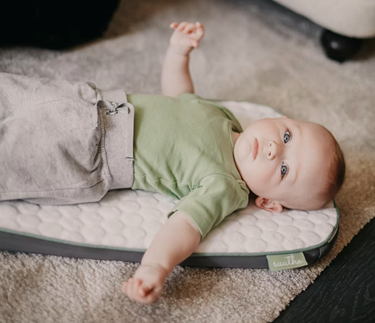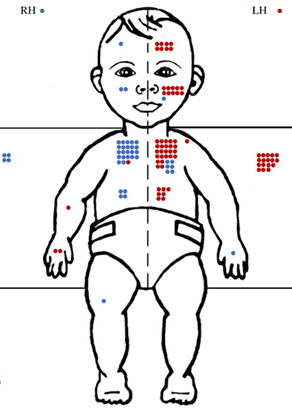6.3: Developing a Sense of Peripersonal Space
- Page ID
- 139863
Peripersonal Space
Throughout the first few months, infants move their limbs frequently (driven initially by reflexes and later by self-initiation) and as they do, they come into contact with their body and various objects and people around them. While these early movements may not seem important, they are actually a way for infants to begin to learn about themselves and the world around them.
Developing a sense of our body is an essential prerequisite for our interactions with the world. Sensing our body entails knowing where our limbs are in space and time, being aware of how fast or how far our limbs can move, or even knowing how much space our body occupies in our environment. Peripersonal space is defined as the space surrounding the body where we can reach or be reached by external entities, including objects or other individuals. Knowing the limits and extent of our peripersonal space is fundamental for navigating our social and physical world, and for situating and orienting ourselves in everyday activities. [1] [2]

With every touch of their body and surrounding areas, infants are receiving feedback that informs them about their posture, any changes in limb position and about contact with themselves or other surfaces, thereby allowing them to discover knowledge of not only their limbs and their range of motion, but also an understanding of their peripersonal space. These self-generated movements, as infants move their limbs freely, provide a foundation for exploratory behavior and build a basic understanding of body representation and of the world (Hoffmann, 2017). Touches to the body in particular provide information about the limb posture in space, the part of the limb making contact with the body, and the body area being touched (Rochat & Hespos, 1997). [1]
Research that has studied young infants exploring peripersonal space through touch have found that infants produce nearly 200 contacts on their bodies and the surrounding surface area in a 10 minute time period and touch as many as 18 different areas, mainly their upper body and the floor (DiMercurio, Connell, Clark & Corbetta, 2018). Infants also spent about 50% of that time moving their arms in the air, going from one place of contact to another. Figure \(\PageIndex{2}\) maps the frequency of touches to various areas of the body and surrounding surface area from one infant. The blue dots are contacts performed by the infant’s right hand, the red dots are contacts performed by the infant’s left hand. Such touching is fundamental for developing an early sense of the body and for discovering the boundaries of the peripersonal space in which future developing goal-directed actions will take place. In fact, other research has found that greater arm movement in early infancy is related to larger increases in language and cognitive abilities (Shida-Tokeshi et al., 2018). Together, this research suggests that infants are active explorers of their peripersonal space and that these early self-generated sensorimotor experiences form the critical foundation from which future motor behaviors and knowledge of the world develop. [1]

To support the exploration of peripersonal space, infants need time and space to freely move and explore with their limbs. Caregivers can ensure that infants have ample time lying comfortably on their backs on floors to support limb movement. Young infants also need space without the consistent overcrowding of play objects or frequently being placed in an activity gym device. Additionally, infant swings, car seats and many other devices limit limb movement and therefore restrict exploration of peripersonal space. To freely move their limbs, infants need clothes that allow for full-range reaching (compared to clothes or swaddles that reduce limb movement). Realizing how important it is for infants to explore their peripersonal space, caregivers should be cognizant of the significance of providing the time and space for infants to move their limbs as they learn about their bodies and the surrounding surface areas.
[1] DiMercurio et al., (2018). A naturalistic observation of spontaneous touches to the body and environment in the first 2 months of life. Frontiers in Psychology, 9, 2613. CC by 4.0
[2] Rabellino et al., (2020). Peripersonal space and bodily self-consciousness: Implications for psychological trauma-related disorders. Frontiers in Neuroscience, 14, 1256. CC by 4.0
[3] Image from Alex Bodini on Unsplash.
[4] Image adapted from DiMercurio et al., (2018). A naturalistic observation of spontaneous touches to the body and environment in the first 2 months of life. Frontiers in Psychology, 9, 2613. CC by 4.0

